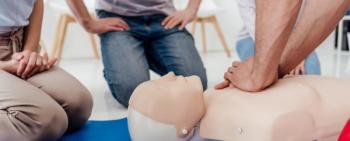
AAP backs statement to eliminate period poverty, increase youth’s access to menstrual hygiene products
The North American Society for Pediatric and Adolescent Gynecology’s position statement to eliminate period poverty has acquired a recent endorsement from the American Academy of Pediatrics.
The American Academy of Pediatrics (AAP) has recently endorsed a position statement made by the North American Society for Pediatric and Adolescent Gynecology (NASPAG) to eliminate period poverty.1
Founded in 1986, NASPAG provides multidisciplinary leadership in gynecologic care, research, and education to improve the reproductive health of youth.2 According to the position statement from NASPAG, millions of adolescents and young adults (AYAs) all over the globe experience pain, shame, anxiety, and isolation resulting from menstrual periods, despite menstruation being a normal and healthy bodily function.3
Period poverty is a time when it is difficult or impossible for individuals to access menstrual hygiene products and necessities due to financial circumstances or inadequate access to menstrual hygiene education.3
On average, a youth’s first menstrual period occurs between 11 and 14 years and continues into their 50s. During the approximately 40 years of this cycle, a menstruator will use more than 8000 disposable products (pads or tampons) and spend an average of $9 per month.3 However, that price is not the full treatment cost. NASPAG states the true cost of menstruation is higher considering pain control, laundry services, lower workforce, and academic productivity.3
Demand for menstrual products is often higher in AYAs because of the often heavy, prolonged, and unpredictable menstrual bleeding due to their proximity to menarche and immaturity of their reproductive hormonal axis.3
Over 500 million people, nearly 25% of all menstruators, experience period poverty despite lacking estimates in peer-reviewed studies for North America. Youth may find it difficult to access necessary menstrual hygiene products due to high cost or even lack of accessibility. This can lead to unsafe practices, according to NASPAG.3
Prolonged use or unsafe use of pads or tampons can result in health consequences such as toxic shock syndrome, outer skin infections, and lower reproductive tract infections, which can further affect AYA’s academic and social life, as well as self-esteem and mental health.3
Though peer-reviewed data in North America is scarce, NASPAG reports period poverty affects menstruating individuals of all ages in the United States, especially those with lower income and those in racialized communities.3
Before COVID-19, 1 in 5 US students struggled to afford menstrual products, rising to nearly 1 in 4 by 2021.3 Repercussions from the lack of menstrual products led to school absences or the need to use makeshift menstrual products.3
Reports indicate that 20% of US girls either left school early or missed school altogether due to a lack of access to menstrual products.3 Increased unemployment, poverty, and remote learning due to COVID-19 have increased the impact of period poverty.3
According to NASPAG, products marketed toward women tend to be more expensive than those for men.3 Further, the association states that sales tax on menstrual products are a form of sex-based discrimination. The American Medical Association (AMA) has called for the elimination of sales tax related to menstrual hygiene products, as the association considers the products essential for women’s health.3 Several countries including Canada, Australia, the United Kingdom, Jamaica, and others have eliminated the tax on menstrual products.3 The majority of states in the United States continue to tax menstrual products.3
To deter the many potentially dangerous effects of period poverty, NASPAG outlines several initial steps to eliminate it.
Understanding menses is a vital sign.3 Factors that impact menstrual health should be important to medical providers.3 Patients should feel they can have open conversations with medical providers about menstrual products and any potential restrictions to accessing them.3 Health care providers should focus education of both menstruators and non-menstruators.3 Collaborating with youth and their families, school administrators and teachers can increase the reach of education to negate stigma associated with menstrual stigma. Further peer-reviewed studies addressing period poverty in AYAs around the world to shed light on their experiences.3
Reference
- Sulaski Wyckoff A. ‘Period poverty’: AAP endorses statement on improving access to menstrual products. AAP News. March 27, 2023. Accessed March 29, 2023. https://publications.aap.org/aapnews/news/23783/Period-poverty-AAP-endorses-statement-on-improving
- About us. NASPAG. Accessed March 29, 2023. https://www.naspag.org/about-us#:~:text=The%20North%20American%20Society%20for,the%20reproductive%20health%20of%20youth.
- Harrison ME, Davies S, Tyson N, Swartzendruber A, Grubb LK, Alderman EM. NASPAG position statement: eliminating period poverty in adolescents and young adults living in North America. NASPAG. December 2021. Accessed March 29, 2023. https://www.naspag.org/assets/docs/NASPAG%20Position%20Statement_Period%20Poverty_NASPAGwebsite.pdf
Newsletter
Access practical, evidence-based guidance to support better care for our youngest patients. Join our email list for the latest clinical updates.














